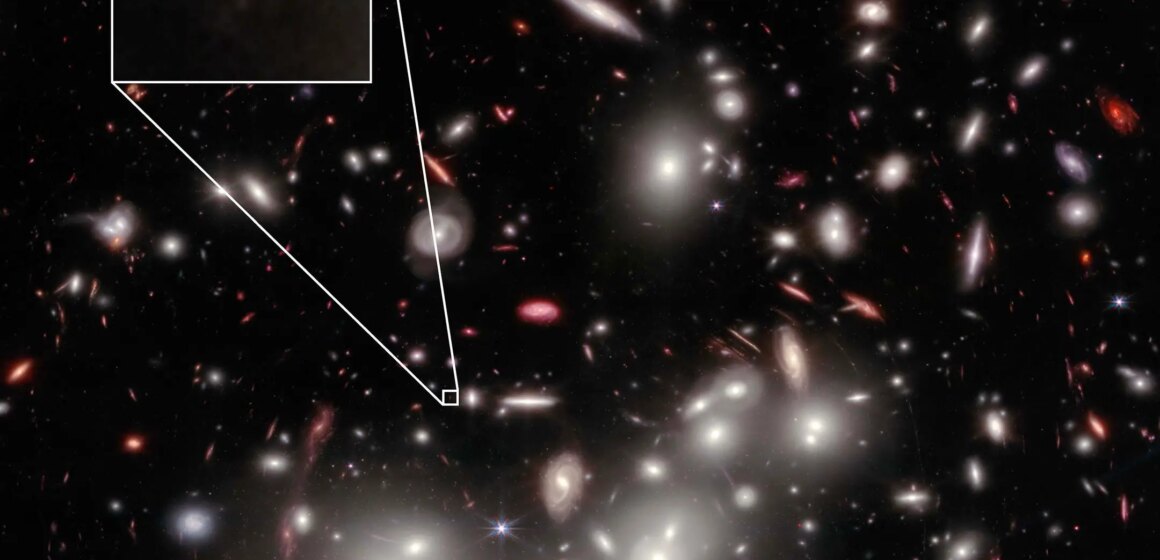A projected image of galaxy JD1 (inset), which lies behind a bright cluster galaxy called Abell2744. Photo: Guido Roberts-Borsani/UCLA); original images: NASA, ESA, CSA, Swinburne University of Technology, University of Pittsburgh, STScI
An international research team has confirmed the existence of the faintest galaxy ever observed in the early universe, JD1. This discovery was made with the help of An international research team led by astrophysicists from the University of California, Los Angeles (UCLA) has confirmed the existence of the faintest galaxy ever seen in the early universe. The galaxy, called JD1, is one of the most distant yet identified and is typical of the types of galaxies that burned through the haze of hydrogen atoms left over from the Big Bang, allowing light to shine through the universe and shape it into what it is today .
The discovery was made using NASA’s James Webb Space Telescope and the findings were published in the journal Nature.
The first billion years of the universe’s life were a crucial period in its evolution. After the Big Bang, approximately 13.8 billion years ago, the universe expanded and cooled enough for hydrogen atoms to form. Hydrogen atoms absorb ultraviolet photons from young stars; however, by the time the first stars and galaxies were born, the universe had gone dark and entered a period known as the cosmic dark ages. The appearance of the first stars and galaxies several hundred million years later bathed the universe in energetic ultraviolet light, which began to burn or ionize the hydrogen fog. This in turn allowed photons to travel through space, making the universe transparent.
Determining the types of galaxies that dominated that era — called the Age of Reionization — is a major goal in astronomy today, but until the development of the Webb Telescope, scientists lacked the sensitive infrared instruments needed to study the first generation of galaxies.
“Most of the galaxies discovered with JWST so far are bright galaxies, which are rare and not thought to be particularly representative of the young galaxies that populated the early universe,” said Guido Roberts-Borsani, a postdoctoral researcher at UCLA and first author of the study. “As such, while important, they are not thought to be the main agents that burned up all that hydrogen fog.
“Ultrafaint galaxies like JD1, on the other hand, are much more numerous, so we believe they are more representative of galaxies that have undergone the reionization process, allowing ultraviolet light to travel unhindered through space and time.”
JD1 is so dark and so far away that it’s a challenge to study it without a powerful telescope — and a helping hand from nature. JD1 lies behind a large nearby galaxy cluster called Abell 2744, whose combined gravitational force bends and amplifies the light from JD1, making it appear larger and 13 times brighter than it would otherwise appear. The effect, known as gravitational lensing, is similar to how a magnifying glass distorts and amplifies light in its field of view; without gravitational lensing, JD1 would likely be missed.
The researchers used the Webb Telescope’s Near Infrared Spectrograph instrument, NIRSpec, to obtain an infrared light spectrum of the galaxy, allowing them to determine its exact age and distance from Earth, as well as the number of stars and the amount of dust and heavy elements that has formed in its relatively short life.
The combination of the galaxy’s gravitational magnification and new images from another near-infrared instrument on the Webb telescope, NIRCam, also made it possible for the team to study the galaxy’s structure in unprecedented detail and resolution, revealing three main elongated clumps of star-forming dust and gas. The team used the new data to trace JD1’s light back to its original source and shape, revealing a compact galaxy that is only a fraction of the size of older galaxies such as DOI: 10.1038/s41586-023-05994-w

